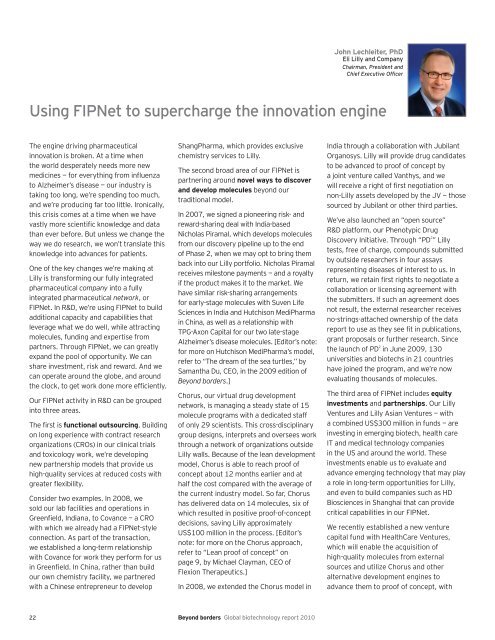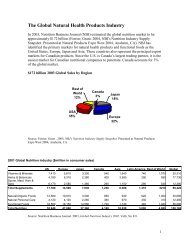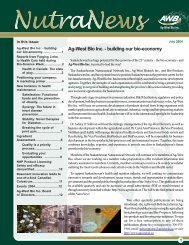Beyond Borders: Global biotechnology report 2010
Beyond Borders: Global biotechnology report 2010
Beyond Borders: Global biotechnology report 2010
Create successful ePaper yourself
Turn your PDF publications into a flip-book with our unique Google optimized e-Paper software.
Using FIPNet to supercharge the innovation engine<br />
The engine driving pharmaceutical<br />
innovation is broken. At a time when<br />
the world desperately needs more new<br />
medicines — for everything from influenza<br />
to Alzheimer’s disease — our industry is<br />
taking too long, we’re spending too much,<br />
and we’re producing far too little. Ironically,<br />
this crisis comes at a time when we have<br />
vastly more scientific knowledge and data<br />
than ever before. But unless we change the<br />
way we do research, we won’t translate this<br />
knowledge into advances for patients.<br />
One of the key changes we’re making at<br />
Lilly is transforming our fully integrated<br />
pharmaceutical company into a fully<br />
integrated pharmaceutical network, or<br />
FIPNet. In R&D, we’re using FIPNet to build<br />
additional capacity and capabilities that<br />
leverage what we do well, while attracting<br />
molecules, funding and expertise from<br />
partners. Through FIPNet, we can greatly<br />
expand the pool of opportunity. We can<br />
share investment, risk and reward. And we<br />
can operate around the globe, and around<br />
the clock, to get work done more efficiently.<br />
Our FIPNet activity in R&D can be grouped<br />
into three areas.<br />
The first is functional outsourcing. Building<br />
on long experience with contract research<br />
organizations (CROs) in our clinical trials<br />
and toxicology work, we’re developing<br />
new partnership models that provide us<br />
high-quality services at reduced costs with<br />
greater flexibility.<br />
Consider two examples. In 2008, we<br />
sold our lab facilities and operations in<br />
Greenfield, Indiana, to Covance — a CRO<br />
with which we already had a FIPNet-style<br />
connection. As part of the transaction,<br />
we established a long-term relationship<br />
with Covance for work they perform for us<br />
in Greenfield. In China, rather than build<br />
our own chemistry facility, we partnered<br />
with a Chinese entrepreneur to develop<br />
ShangPharma, which provides exclusive<br />
chemistry services to Lilly.<br />
The second broad area of our FIPNet is<br />
partnering around novel ways to discover<br />
and develop molecules beyond our<br />
traditional model.<br />
In 2007, we signed a pioneering risk- and<br />
reward-sharing deal with India-based<br />
Nicholas Piramal, which develops molecules<br />
from our discovery pipeline up to the end<br />
of Phase 2, when we may opt to bring them<br />
back into our Lilly portfolio. Nicholas Piramal<br />
receives milestone payments — and a royalty<br />
if the product makes it to the market. We<br />
have similar risk-sharing arrangements<br />
for early-stage molecules with Suven Life<br />
Sciences in India and Hutchison MediPharma<br />
in China, as well as a relationship with<br />
TPG-Axon Capital for our two late-stage<br />
Alzheimer’s disease molecules. [Editor’s note:<br />
for more on Hutchison MediPharma’s model,<br />
refer to “The dream of the sea turtles,” by<br />
Samantha Du, CEO, in the 2009 edition of<br />
<strong>Beyond</strong> borders.]<br />
Chorus, our virtual drug development<br />
network, is managing a steady state of 15<br />
molecule programs with a dedicated staff<br />
of only 29 scientists. This cross-disciplinary<br />
group designs, interprets and oversees work<br />
through a network of organizations outside<br />
Lilly walls. Because of the lean development<br />
model, Chorus is able to reach proof of<br />
concept about 12 months earlier and at<br />
half the cost compared with the average of<br />
the current industry model. So far, Chorus<br />
has delivered data on 14 molecules, six of<br />
which resulted in positive proof-of-concept<br />
decisions, saving Lilly approximately<br />
US$100 million in the process. [Editor’s<br />
note: for more on the Chorus approach,<br />
refer to “Lean proof of concept” on<br />
page 9, by Michael Clayman, CEO of<br />
Flexion Therapeutics.]<br />
In 2008, we extended the Chorus model in<br />
22 <strong>Beyond</strong> borders <strong>Global</strong> <strong>biotechnology</strong> <strong>report</strong> <strong>2010</strong><br />
John Lechleiter, PhD<br />
Eli Lilly and Company<br />
Chairman, President and<br />
Chief Executive Officer<br />
India through a collaboration with Jubilant<br />
Organosys. Lilly will provide drug candidates<br />
to be advanced to proof of concept by<br />
a joint venture called Vanthys, and we<br />
will receive a right of first negotiation on<br />
non-Lilly assets developed by the JV — those<br />
sourced by Jubilant or other third parties.<br />
We’ve also launched an “open source”<br />
R&D platform, our Phenotypic Drug<br />
Discovery Initiative. Through “PD 2<br />
” Lilly<br />
tests, free of charge, compounds submitted<br />
by outside researchers in four assays<br />
representing diseases of interest to us. In<br />
return, we retain first rights to negotiate a<br />
collaboration or licensing agreement with<br />
the submitters. If such an agreement does<br />
not result, the external researcher receives<br />
no-strings-attached ownership of the data<br />
<strong>report</strong> to use as they see fit in publications,<br />
grant proposals or further research. Since<br />
the launch of PD 2<br />
in June 2009, 130<br />
universities and biotechs in 21 countries<br />
have joined the program, and we’re now<br />
evaluating thousands of molecules.<br />
The third area of FIPNet includes equity<br />
investments and partnerships. Our Lilly<br />
Ventures and Lilly Asian Ventures — with<br />
a combined US$300 million in funds — are<br />
investing in emerging biotech, health care<br />
IT and medical technology companies<br />
in the US and around the world. These<br />
investments enable us to evaluate and<br />
advance emerging technology that may play<br />
a role in long-term opportunities for Lilly,<br />
and even to build companies such as HD<br />
Biosciences in Shanghai that can provide<br />
critical capabilities in our FIPNet.<br />
We recently established a new venture<br />
capital fund with HealthCare Ventures,<br />
which will enable the acquisition of<br />
high-quality molecules from external<br />
sources and utilize Chorus and other<br />
alternative development engines to<br />
advance them to proof of concept, with








